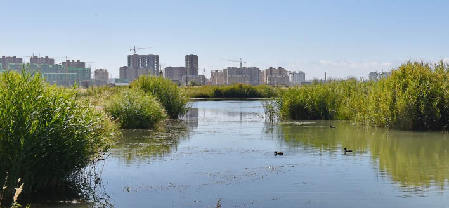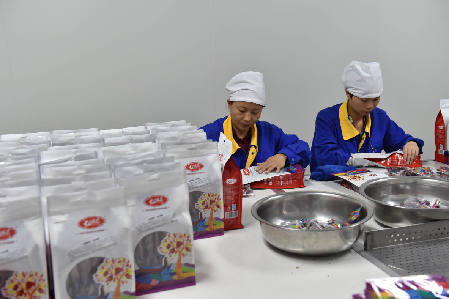Green Zhangye
By staff reporters YAO BEI & MICHAEL ZÁRATE
ZHANGYE in northwest China is a famous historical city that occupied a strategic location on the legendary Silk Road. It covers a 42,000-square-kilometer area and has a population of 1.3 million. The name “Zhangye” means to stretch out the arms of the country to the Western realms. Zhangye was indeed the gateway connecting China with Western culture and business opportunities. During the Yuan Dynasty (1271-1368), Venetian traveler Marco Polo recorded in his Travels of Marco Polo what he experienced and observed during the year he spent in the city of Campichu, since identified as Ganzhou, as Zhangye was formerly known. He described in detail the scale of the city, the affluent lifestyle of its large population and their diverse religions, and Zhangye’s magnificent temples, mosques and churches.
Today, under the background of the Chinese government’s promotion of energy conservation and emissions reduction, sustainable development, and the Belt and Road Initiative, the focus of the local Zhangye government is, and has for the past four years been on building an eco-friendly economy. It will achieve this through proactive development of low-carbon, environmentally-friendly, non-polluting industries, such as tourism, sports, culture, convention and exhibition industry, and modern agriculture. Its aim is to make Zhangye an eco-city.
 |
| Zhangye National Wetland Park, which serves as the “lungs” of the city and a natural oxygen bar. |
Critical to Ecological Security
There are three coexistent eco-systems in Zhangye – the Qilian Mountains, which are crucial to water resource conservation, the Heihe River wetland, and the Gobi Desert. Its special geographical location makes the city critical to safeguarding China’s ecological security.
The Qilian Mountains serve as a boundary in Zhangye between the Qinghai-Tibet Plateau, with an average altitude of between 2,800 to 4,000 meters, to the south, and the Inner Mongolian Plateau and Loess Plateau to the north. To the east is the North China Plain. The Qilian mountain range extends around 1,000 kilometers, and a long stretch of their northern slopes is in Zhangye. Amid the mountains are the sources of many rivers, among them the Heihe River. The country’s second longest inland river, it flows through and nourishes Zhangye, forming large fertile areas in the city, so rendering Zhangye a desert oasis. The other three rivers that nourish neighboring cities like Wuwei, Jiuquan, and Dunhuang also originate in Zhangye. Any damage to Zhangye’s eco-environment would affect the ecology of the Qilian Mountains and of the Qinghai-Tibet Plateau to its south, as well as the rivers whose sources are in the mountains or on the plateau. It would thus have considerable impact on China’s headwater region. Zhangye also serves as a natural barrier against sandstorms from the Inner Mongolian Plateau, so preventing desertification of the Qinghai-Tibet Plateau.
Zhangye, therefore, is vital to the protection of the entire country’s ecological security. Owing, however, to its high altitude and location in an inland desert region where water resources are scarce, Zhangye’s eco-environment is extremely fragile. This poses a huge challenge to the local government’s efforts to build an eco-city.
“In light of Zhangye’s special status as guardian of ecological security, we take eco-environmental protection as our foremost task, and so aim to develop an economy based on low- or even non-pollution. We want to make our city a place where citizens can thrive economically and enjoy their lives,” Mayor Huang Zeyuan of Zhangye said.
By the end of 2017, Zhangye will be site of an estimated 35,300 hectares of afforestation, and about 16,667 hectares of new forests, which adds up to a green coverage rate of 17.7 percent. The local government has also focused on developing alternative energy to reduce pollution from traditional energy sources. The city hence plans to develop three million kilowatts of hydro-energy, seven million kilowatts of wind power and 13 million kilowatts of solar energy.
Natural Oxygen Bar
Zhangye National Wetland Park, in northern Zhangye on the eastern bank of the Heihe River, covers a total area of 46.02 square kilometers, 20 square kilometers of which are wetland. The park serves as the “lungs” of the city and a natural oxygen bar. It is home to 195 plants and 116 bird and animal species, the latter of which include wild ducks, swans, red-crowned cranes, vultures, and larger beasts such as the snow leopard. The wetland is also a haven for the dozens of species of migratory birds making their way through Siberia, and Central and South Asia.
Construction of the park started in March 2009. About 18 river channels of a total length of 23 kilometers have been dredged, and 11 cofferdams extending 7.2 kilometers built. Around 210 hectares of degraded farmland has also been converted into wetland. Lakes and ponds, including South Lake, North Lake, Ruyu Lake (meaning jade-like lake) and Fu Pond (meaning good fortune lake), which cover about 66 hectares, have also been dredged. Watered areas in the park total 213 hectares. Moreover, there is an 8.2-kilometer-long plank road and a 20-kilometer-long road on which to travel by electromobile. Visitors to the park can also take part in popular outdoor activities like river floating, boat trips, fishing, and skating. The park was rated a National 4A Scenic Area in 2011.
In line with Zhangye’s policy of letting its citizens enjoy the fruits of the construction of its ecological civilization, the park has free public access. Reeds growing there are used as environmentally friendly construction materials. People thus benefit materially from the wetland park, which makes them even keener to protect it.
Water-Saving
The State Council approved in 1986 the establishment of the Qilian Mountains National Nature Reserve, and in 2011 the Zhangye Heihe River Wetland National Nature Reserve, making Zhangye a city with two national nature reserves at its feet.
Gaotai County, under the jurisdiction of Zhangye, plays an important role in the city’s eco-construction. The Heihe River Wetland Nature Reserve is located here and provides sufficient water resources for the nearby farmland. However, because it is in a desert area, Gaotai County has a fragile ecology.
“Desert expansion causes great concern,” deputy head of Gaotai Publicity Department Tian Yulong said. To protect wetland, the local Gaotai government plants more trees to expand forest areas, and is also developing water-saving agriculture, the surrounding farmland having expanded the drip irrigation system. “Before we needed 120 cubic meters of water for each mu (about 0.06 hectares) farmland, but now use only 20 cubic meters,” Tian said.
Changing crop varieties is another way of saving water. For example, local farmers grow corn, grapes, cotton, tomatoes, and various beans used as cattle forage on almost 20,000 hectares of arable land in Gaotai. But they are no longer permitted to grow rice due to its high water consumption.
 |
| The small Linze Chinese dates produced by Gansu Zeyuan Agricultural Science and Technology Co., Ltd. Photos by Yu Xiangjun |
Circular Economy
In addition to wetland protection, Zhangye tries to diversify development of its industry by focusing on low-carbon sectors.
One example is the Gansu Zeyuan Agricultural Science and Technology Co., Ltd, which was formerly dedicated to the production and marketing of traditional Chinese medicine. In 2012, the company invested RMB 46 million in establishing a production base that applies criteria much higher than normal food production standards. The company utilizes local specialties, such as Chinese dates, wolfberries and sea buck-thorn, as raw material to produce high quality soft drinks. The company also plans to establish a museum of Chinese dates, so developing relevant products and promoting local culture.
Solve the Dilemma
When asked how it is possible to balance economic development and environmental protection, Mayor Huang Zeyuan replied frankly: “This is a perplexing question. I believe the two are not necessarily contradictory, but that it will nevertheless take some time to achieve a balance. All the developed countries have been through this stage.”
Huang shared his experience of observation and study in France. France went through a period of serious damage to its ecology and environment. But today it is one of the leading countries promoting eco-environment protection and reducing greenhouse gas emissions. “France has now entered a more stable development stage where the population growth is slow and people enjoy high material standards of living. Their energy conservation and emission reduction efforts, however, are most apparent in daily life, for example, riding bicycles instead of driving cars, rather than in the production sector. We, in contrast, are still pursuing economic growth, and need to carry out infrastructure construction. Many people want to improve their living conditions and enjoy an affluent life, and that is the situation we must face,” Huang said.
Under such circumstances, the most difficult question Mayor Huang faces is how to negotiate the gap between the government’s environmental protection effort and citizens’ wish for economic development. “On the one hand, the government has realized the importance of eco-environmental protection; that deterioration of Zhangye’s eco-environment will affect not just the city itself, but the ecology of the entire country. We must, therefore, adopt relevant measures. On the other hand, to raise people’s living standards, we need to expand production to achieve further development,” Huang said.
Huang believes that solving the dilemma necessitates support from the central government. “For example, over the past 10 years, we have transferred 15 billion cubic meters of water to Ejina Banner to help improve eco-environment in western Inner Mongolia, thus reducing the threat to Beijing of sandstorms. But Zhangye has paid a huge price. The whole country has benefited enormously from Zhangye’s protection of the eco-environment, so the central government should allocate subsidies to our city. We can then cancel certain construction projects and so reduce impact on our eco-environment,” Huang said.
Transforming the model of production and adjusting the industrial structure are other ways of solving the dilemma. “For example, local herdsmen formerly carried out uncontrolled grazing, causing serious damage to grasslands. We now encourage them to rear cattle in pens, and feed them with cut grass or hay. In this way we effectively reduce damage to natural pasture,” Huang said.
